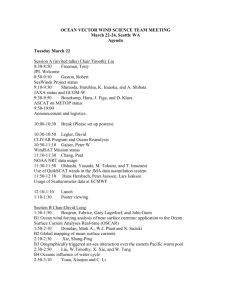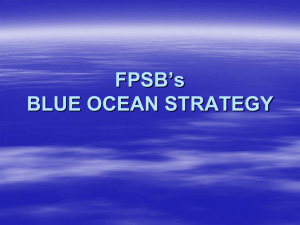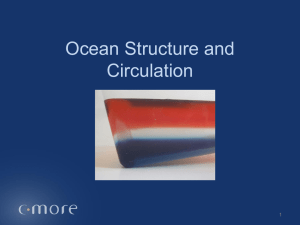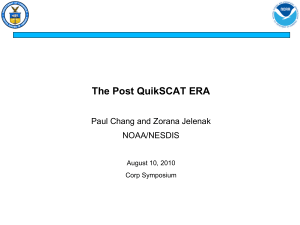observed estimates
advertisement
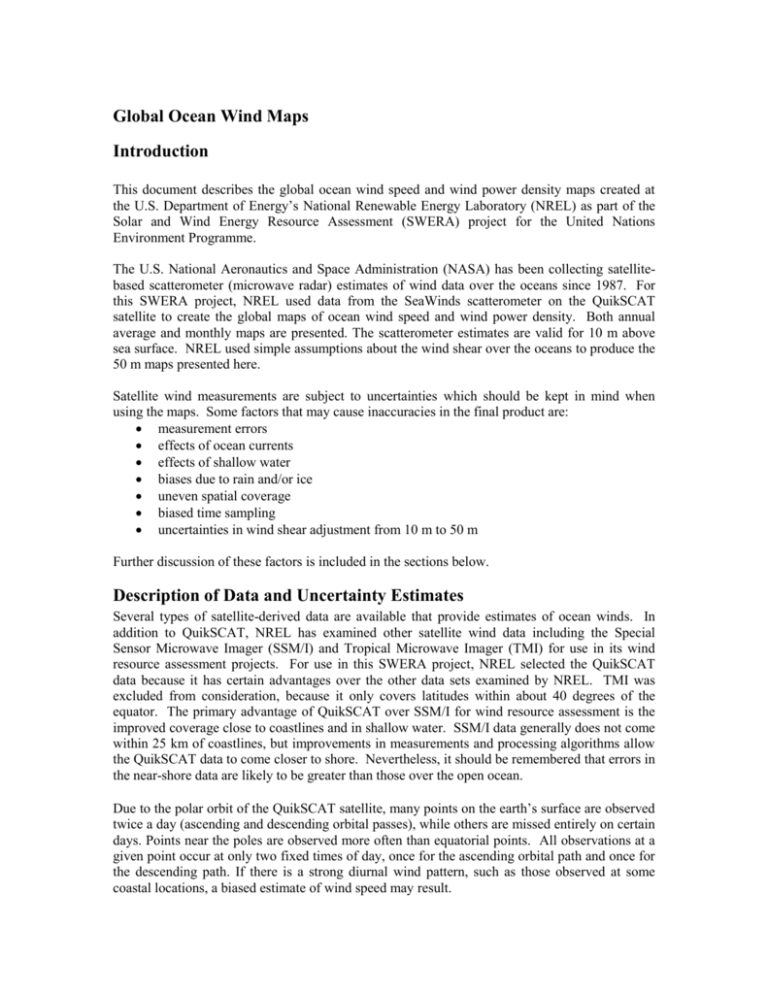
Global Ocean Wind Maps Introduction This document describes the global ocean wind speed and wind power density maps created at the U.S. Department of Energy’s National Renewable Energy Laboratory (NREL) as part of the Solar and Wind Energy Resource Assessment (SWERA) project for the United Nations Environment Programme. The U.S. National Aeronautics and Space Administration (NASA) has been collecting satellitebased scatterometer (microwave radar) estimates of wind data over the oceans since 1987. For this SWERA project, NREL used data from the SeaWinds scatterometer on the QuikSCAT satellite to create the global maps of ocean wind speed and wind power density. Both annual average and monthly maps are presented. The scatterometer estimates are valid for 10 m above sea surface. NREL used simple assumptions about the wind shear over the oceans to produce the 50 m maps presented here. Satellite wind measurements are subject to uncertainties which should be kept in mind when using the maps. Some factors that may cause inaccuracies in the final product are: measurement errors effects of ocean currents effects of shallow water biases due to rain and/or ice uneven spatial coverage biased time sampling uncertainties in wind shear adjustment from 10 m to 50 m Further discussion of these factors is included in the sections below. Description of Data and Uncertainty Estimates Several types of satellite-derived data are available that provide estimates of ocean winds. In addition to QuikSCAT, NREL has examined other satellite wind data including the Special Sensor Microwave Imager (SSM/I) and Tropical Microwave Imager (TMI) for use in its wind resource assessment projects. For use in this SWERA project, NREL selected the QuikSCAT data because it has certain advantages over the other data sets examined by NREL. TMI was excluded from consideration, because it only covers latitudes within about 40 degrees of the equator. The primary advantage of QuikSCAT over SSM/I for wind resource assessment is the improved coverage close to coastlines and in shallow water. SSM/I data generally does not come within 25 km of coastlines, but improvements in measurements and processing algorithms allow the QuikSCAT data to come closer to shore. Nevertheless, it should be remembered that errors in the near-shore data are likely to be greater than those over the open ocean. Due to the polar orbit of the QuikSCAT satellite, many points on the earth’s surface are observed twice a day (ascending and descending orbital passes), while others are missed entirely on certain days. Points near the poles are observed more often than equatorial points. All observations at a given point occur at only two fixed times of day, once for the ascending orbital path and once for the descending path. If there is a strong diurnal wind pattern, such as those observed at some coastal locations, a biased estimate of wind speed may result. Estimates of ocean winds in the QuikSCAT data set are derived from scatterometer measurements of the state of the ocean surface. The scatterometer measures the ocean surface roughness (how calm or turbulent the ocean surface is over the area beneath the satellite). The ocean surface data is then converted to an estimate of the winds 10 m above the ocean surface. The accuracy of a specific wind measurement is ±2 m/s, and the accuracy of an annual average wind speed is estimated to be about ±1 m/s. Validation of satellite-derived ocean winds is generally limited to specific regions where measurement data are available and these measurements are largely from buoys. There are ongoing studies by the organizations that produce the satellite ocean wind data and others to improve the accuracy of these data and reduce the biases among the different satellite data sets. The 1 m/s uncertainty in annual average wind speed translates to an uncertainty of 30%-50% in wind power density, or up to 2 wind power classes, for average speeds of 5-10 m/s. In some areas, such as near shore areas or regions where large biases may be evident, larger uncertainties up to 2 m/s (or 3-4 wind power classes) or more may exist. Uncertainties for monthly average values may be greater than those for the annual average. NREL has not validated the wind resource estimates from these QuikSCAT data. NREL has observed that satellite-derived estimates of wind resource in near-shore, coastal, and island areas do not always agree with high-quality anemometer wind measurements. Therefore, satellite estimates in these areas should be compared with available wind measurements wherever possible. Data Source QuikSCAT data are analyzed, reprocessed and distributed by Remote Sensing Systems, Inc. (RSS) of Santa Rosa, CA. RSS requests that projects using their data include the following statement: QuikSCAT data are produced by Remote Sensing Systems and sponsored by the NASA Ocean Vector Winds Science Team. Data are available at www.remss.com. RSS distributes the QuikSCAT data in daily gridded data files with a cell size of 0.25 degrees (latitude and longitude), the same cell size that is used for the global wind maps. RSS also distributes monthly averaged files, but these were not used since the averaging process would lead to lower than realistic wind power densities. The number of observations in a given grid cell and a given month can range from 0 to 62 (31 days times 2 passes per day). The average number of daily observations for cells near the equator is about 1.3, while cells near the pole have 2 observations per day (the maximum number that will fit into the file format). Sources of Measurement Error The basic assumption that local wind conditions are driving force of the state of the ocean surface holds true over much of the world. However, there are other factors besides the local wind conditions that can affect the state of the ocean surface. Strong ocean currents have an influence on the ocean surface, and large-scale ocean swells combined with shallower ocean depths near continents and large islands can also change the state of the ocean surface. These factors can introduce biases in the ocean wind estimates in some regions. Low clouds and precipitation adversely affect the signal from microwave radar, leading to lower data coverage. Therefore, the ocean wind estimates tend to be biased for conditions that occur during clear or partly cloudy weather. The estimates for ocean regions influenced primarily by large-scale weather systems may not be biased because of this factor, but regions with distinct wet and dry seasons are likely to have some bias in the wind speed and power estimates. Certain areas (e.g., the Aral, Black and Caspian Seas) have data quality problems, even after excluding data flagged as occurring with precipitation. This is a known problem and speed and power estimates in these regions should be used with caution. Period of Record The maps were created using data collected over the 5-year (60-month) period between January 1, 2000 and December 31, 2004. QuikSCAT data coverage started in July 1999 and continues at the present time, but this 5-year period was chosen to give a uniform seasonal distribution. Method Daily files of gridded wind speeds were downloaded from the RSS ftp site and analyzed. Grid cells with wind speeds greater than 25.0 m/s were discarded, as were cells that were flagged as having rain or sea ice. All daily files for a given month (e.g., December 2001) were combined into an average monthly file that includes both speed and power averages. Cells with fewer than 4 observations in a given month were discarded. Most of these low-observation cells are near coastlines. The five monthly files for each month (e.g., June of 2000, 2001, 2002, 2003 and 2004) were used to create composite monthly files. Cells with fewer than 4 valid monthly files were not used for the map. The monthly global wind speed and power maps show data from these composite monthly files. The twelve monthly files for a given year were averaged into a composite file for that year. Values for grid cells with fewer than 9 months of valid data were not computed. The five yearly composite files were then averaged into a composite annual file. Cells with fewer than 4 valid annual files were not used for the annual map. The average global wind speed and power maps show data from this composite annual file. The composite averages were computed by averaging the monthly or yearly averages, with each input weighted equally, regardless of the number of observations in each component file. This process eliminates any bias that may be caused by different numbers of observations in different years or months. Speed Wind speed at 10 m above the ocean surface is the primary quantity measured by the QuikSCAT scatterometer. Average values for a month were computed by simply summing all qualifying observations and dividing by the number of observations. Power Average wind power densities (WPDs) were computed for each monthly file by computing a WPD for each observation and averaging over all observations: WPD = 0.5*rho*ws3 where ws is the measured wind speed and rho is the air density. A value of rho = 1.225 kg/m3 was used for all observations, regardless of season or latitude. Adjustment to 50 m Because the satellite estimates are valid at a height of 10 m above the ocean surface, wind speed and wind power shear adjustments need to be applied to calculate the 50 m map values. In this case, NREL used power law exponents of 0.10 and 0.30 to adjust the wind speed and wind power respectively from 10 m to 50 m, resulting in multiplicative factors of 1.17 for speed and 1.62 for power. This adjustment was applied to all areas on all the maps, both annual and monthly. Overall, we believe these shear values a fairly representative of open ocean values. However, climatic conditions can cause the actual shear values to range from well below 0.10 (0.30 for power) to above 0.15 (0.45 for power) in specific areas. Shear values also change seasonally. There was no attempt on these maps to identify regions of relatively low and high ocean wind shear, nor were any seasonal corrections applied. References http://winds.jpl.nasa.gov/missions/quikscat/index.cfm description - NASA/JPL QuikSCAT mission http://winds.jpl.nasa.gov/ - NASA/JPL ocean winds project http://www.ssmi.com/qscat/qscat_description.html - a description of the QuikSCAT database http://www.ssmi.com/papers/Advanced_Algorithms_for_QuikSCAT_and_SeaWinds AMSR_IGARSS_2001.pdf - discussion of algorithms and corrections used to process QuikScat data http://www.ssmi.com/qscat/qscat_description.html#known_problems – a description of problems with sea ice and land exposure





